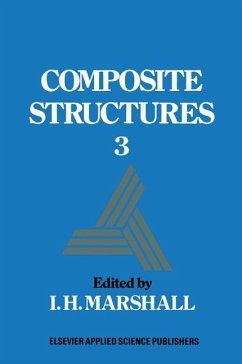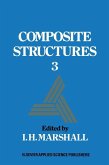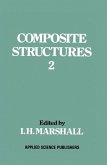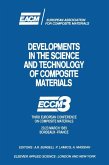- Gebundenes Buch
- Merkliste
- Auf die Merkliste
- Bewerten Bewerten
- Teilen
- Produkt teilen
- Produkterinnerung
- Produkterinnerung
The papers contained herein were presented at the Third International Conference on Composite Structures (ICCS/3) held at Paisley College of Technology, Paisley, Scotland, in September 1985. The Conference was organised and sponsored by Paisley College of Technology. It was co sponsored by the Scottish Development Agency, the National Engineering Laboratory, the USAF European Office of Aerospace Research and Development, and the US Army Research, Development and Standard isation Group-UK. It forms a natural and ongoing progression from the highly successful First and Second International…mehr
Andere Kunden interessierten sich auch für
![Composite Structures 3 Composite Structures 3]() Composite Structures 3385,99 €
Composite Structures 3385,99 €![Composite Structures 2 Composite Structures 2]() Composite Structures 239,99 €
Composite Structures 239,99 €![Advanced Materials and Structures for Extreme Operating Conditions Advanced Materials and Structures for Extreme Operating Conditions]() Jacek J. SkrzypekAdvanced Materials and Structures for Extreme Operating Conditions110,99 €
Jacek J. SkrzypekAdvanced Materials and Structures for Extreme Operating Conditions110,99 €![Developments in the Science and Technology of Composite Materials Developments in the Science and Technology of Composite Materials]() Developments in the Science and Technology of Composite Materials75,99 €
Developments in the Science and Technology of Composite Materials75,99 €![Developments in the Science and Technology of Composite Materials Developments in the Science and Technology of Composite Materials]() Developments in the Science and Technology of Composite Materials77,99 €
Developments in the Science and Technology of Composite Materials77,99 €![Composite Structures 4 Composite Structures 4]() Composite Structures 477,99 €
Composite Structures 477,99 €![Advanced Technology for Design and Fabrication of Composite Materials and Structures Advanced Technology for Design and Fabrication of Composite Materials and Structures]() Advanced Technology for Design and Fabrication of Composite Materials and Structures116,99 €
Advanced Technology for Design and Fabrication of Composite Materials and Structures116,99 €-
-
-
The papers contained herein were presented at the Third International Conference on Composite Structures (ICCS/3) held at Paisley College of Technology, Paisley, Scotland, in September 1985. The Conference was organised and sponsored by Paisley College of Technology. It was co sponsored by the Scottish Development Agency, the National Engineering Laboratory, the USAF European Office of Aerospace Research and Development, and the US Army Research, Development and Standard isation Group-UK. It forms a natural and ongoing progression from the highly successful First and Second International Conferences on Composite Structures (ICCS/l and ICCS/2) held at Paisley in 1981 and 1983, respectively. To label composites as rather specialised, sophisticated, space-age structural materials would be to underestimate greatly their wider industrial potential. It is unquestionably true that they will play an increasingly dominant, if not decisive, role in aerospace engineering. Indeed a future aircraft industry without composites as the prime structural materials is inconceivable. However, in an energy-conscious world the high specific weights and stiffnesses of composites make them an attractive proposition in every sphere of transportation engineering. This fact is soundly underlined in one of the Plenary papers contained herein and in one of the sessions devoted to this subject. I t would also be a considerable mistake to interpret composites as simply lightweight alternatives to conventional metallic structural materials.
Produktdetails
- Produktdetails
- Verlag: Springer / Springer Netherlands
- Artikelnr. des Verlages: 978-0-85334-378-3
- 1985.
- Seitenzahl: 844
- Erscheinungstermin: 30. September 1985
- Englisch
- Abmessung: 235mm x 157mm x 50mm
- Gewicht: 1346g
- ISBN-13: 9780853343783
- ISBN-10: 0853343780
- Artikelnr.: 24225647
- Verlag: Springer / Springer Netherlands
- Artikelnr. des Verlages: 978-0-85334-378-3
- 1985.
- Seitenzahl: 844
- Erscheinungstermin: 30. September 1985
- Englisch
- Abmessung: 235mm x 157mm x 50mm
- Gewicht: 1346g
- ISBN-13: 9780853343783
- ISBN-10: 0853343780
- Artikelnr.: 24225647
Plenary Session.- 1. Durability Predictions of Adhesively Bonded Composite Structures Using Accelerated Characterization Methods.- 2. Structural Automotive Components in Fibre Reinforced Plastics.- Session I: Fatigue Studies.- 3. Optimization of Fibre Reinforced Composite Laminates Subject to Fatigue Loading.- 4. Damage Development in Notched Carbon Fibre Composites Subjected to Fatigue Loading.- 5. Fatigue Scatter of UD Glass, a Fact or Fiction?.- Session II: Aerospace Aspects.- 6. The Material Development, Component Manufacture and Post-service Evaluation of RB 211-524 Cowl Doors Utilising Carbon Fibre Composite Materials.- 7. Thermal Engineering of Spacecraft Composite Structures.- 8. Structural Certification and In-service Flight Experience of the RB 21l-524 Fan Cowl Doors Utilising Carbon Fibre Composite Materials.- Session III: Design (1)-General Principles.- 9. A Structural Analysis Code Selection Criterion.- 10. Optimum Design of Composite Structures.- 11. Integrated Design of Composite and Hybrid Structural Elements.- Session IV: Design (2)-Examples.- 12. FRP Geodesic Domes: One Example.- 13. Composite-oriented Variable Section Design and Buckling Strength of Long Columns.- 14. Design Details of Integral Flanges for the Ends of Very Large Composite Fiber Structures.- Session V: Automotive Aspects.- 15. Finite Element Computation of Cord-Rubber Systems.- 16. Composites in Engineering: Four Years of Progress?.- Session VI: Cementatious Composites.- 17. Some Mechanical Properties of Glass Reinforced Concrete at Elevated Temperatures.- 18. Melt Extract Fibre Reinforced Sprayed Concrete.- 19. The Stiffness and Strength of Small Diameter Steel Fibres in Cementitious Composites.- Session VII: Platework Postbuckling Studies.- 20. Axisymmetric Postbuckling ofOrthotropic Thick Circular Plates.- 21. Postbuckling of Composite Plates under Inplane Compressive and Shear Loading Having Edges Elastically Restrained Against Rotation.- 22. Postbuckling Failure of Composite Panels.- 23. Elastic Postbuckling of Orthotropic Circular and Annular Plates with Imperfections.- Session VIII: Failure Analysis.- 24. Delamination Criterion Identification for Multilayered Composite Laminates (with the PAM-FISS/Bi-phase Numerical Model).- 25. Modeling the Failure Strength of Notched Graphite/Polyimide Plates Subjected to Extreme Temperatures.- 26. Mechanical Properties and Fractographic Examination of Failure Created in Static Mechanical Testing of CFRP.- 27. A Rational Approach to the Analysis of Delaminated Composite Panels.- Session IX: Damage Tolerance.- 28. Compressive Strengths of Impact Damaged Graphite Epoxy Laminates.- 29. Mechanical and Optical Assessments of Damage During Tensile and Fatigue Tests in Glass Taffeta Fabric-Epoxy Laminate.- 30. Damage Tolerant Composite Design Development.- Session X: Stiffened Structures.- 31. Finite Element Analysis of Conventional and Bimodulus Laminated Composite Stiffened Shell Structures.- 32. Buckling of Unstiffened/Stiffened Orthotropic Foam Sandwich Cylindrical Shells.- 33. Compressive Strength of Longitudinally Stiffened GRP Panels.- Session XI: Non-destructive Evaluation.- 34. Study of First Ply Failure in CFRP by Non-destructive Evaluation.- 35. The Non-destructive Evaluation of Composite Bonded Joints.- Session XII: Pipes and Pressure Vessels.- 36. In-plane and Out-of-plane Flexibility and Stress Intensification Factors of Smooth CSM Bends.- 37. The Horizontal GRP Storage Vessel: A Study of the Stresses in the Support Region.- 38. Design Stress Considerations for GRP Components of Power Station Cooling-water Systems.- Session XIII: Jointing Systems.- 39. The Mechanical Testing and Computer Modelling of Composite Bonded Joints.- 40. Aluminum Inserts for Fastening Sheet Moulding Compounds.- Session XIV: Fracture Mechanics.- 41. The Accuracy of Approximate Solutions in the Analysis of Fracture of Composites.- 42. Crack Growth in Duplex Plates.- 43. Effect of Partially Debonded Inhomogeneities on the Fracture Toughness of an Elastic Matrix.- Session XV: Vibration.- 44. Some Influences of Material Properties on the Dynamic Response of CFRP Structures.- 45. Nonlinear Dynamic Analysis of Composite Moderately Thick Triangular Plates.- 46. Transverse Shear Influence on Calculus of Natural Frequencies of Sandwich Beams.- 47. The Influence of Shear Deformation on the Natural Frequencies of Laminated Rectangular Plates.- Session XVI: Platework Studies.- 48. Analysis of the Large Deflection Behaviour of Laminated Composite Plates Using the Finite Strip Method.- 49. Qualitative Flutter Analysis of Composite Plates.- 50. Large Amplitude Forced Vibration Response of Laminated Composite Rectangular Plates by a Finite Element Method.- Session XVII: Materials Aspects.- 51. Stress Corrosion of Chopped Strand Mat Pipe.- 52. Viscoplastic Strains of a Glass Woven Fabric Based Laminate.- Session XVIII: Experimental Techniques.- 53. Strain Gauges on Glass Fibre Reinforced Polyester Laminates.- 54. Method to Determine the Complete Three-Dimensional Elastic Compliance Matrix of Composite Materials.- Session XIX: Natural Fibre Composites.- 55. Sisal-Cement Composites and their Potential for Rural Africa.- Session XX: Lightweight Structures.- 56. Some Short and Long Term Loading Characteristics of a Double Layer Skeletal Structure Manufactured from Pultruded Composites.- Index of Contributors.
Plenary Session.- 1. Durability Predictions of Adhesively Bonded Composite Structures Using Accelerated Characterization Methods.- 2. Structural Automotive Components in Fibre Reinforced Plastics.- Session I: Fatigue Studies.- 3. Optimization of Fibre Reinforced Composite Laminates Subject to Fatigue Loading.- 4. Damage Development in Notched Carbon Fibre Composites Subjected to Fatigue Loading.- 5. Fatigue Scatter of UD Glass, a Fact or Fiction?.- Session II: Aerospace Aspects.- 6. The Material Development, Component Manufacture and Post-service Evaluation of RB 211-524 Cowl Doors Utilising Carbon Fibre Composite Materials.- 7. Thermal Engineering of Spacecraft Composite Structures.- 8. Structural Certification and In-service Flight Experience of the RB 21l-524 Fan Cowl Doors Utilising Carbon Fibre Composite Materials.- Session III: Design (1)-General Principles.- 9. A Structural Analysis Code Selection Criterion.- 10. Optimum Design of Composite Structures.- 11. Integrated Design of Composite and Hybrid Structural Elements.- Session IV: Design (2)-Examples.- 12. FRP Geodesic Domes: One Example.- 13. Composite-oriented Variable Section Design and Buckling Strength of Long Columns.- 14. Design Details of Integral Flanges for the Ends of Very Large Composite Fiber Structures.- Session V: Automotive Aspects.- 15. Finite Element Computation of Cord-Rubber Systems.- 16. Composites in Engineering: Four Years of Progress?.- Session VI: Cementatious Composites.- 17. Some Mechanical Properties of Glass Reinforced Concrete at Elevated Temperatures.- 18. Melt Extract Fibre Reinforced Sprayed Concrete.- 19. The Stiffness and Strength of Small Diameter Steel Fibres in Cementitious Composites.- Session VII: Platework Postbuckling Studies.- 20. Axisymmetric Postbuckling ofOrthotropic Thick Circular Plates.- 21. Postbuckling of Composite Plates under Inplane Compressive and Shear Loading Having Edges Elastically Restrained Against Rotation.- 22. Postbuckling Failure of Composite Panels.- 23. Elastic Postbuckling of Orthotropic Circular and Annular Plates with Imperfections.- Session VIII: Failure Analysis.- 24. Delamination Criterion Identification for Multilayered Composite Laminates (with the PAM-FISS/Bi-phase Numerical Model).- 25. Modeling the Failure Strength of Notched Graphite/Polyimide Plates Subjected to Extreme Temperatures.- 26. Mechanical Properties and Fractographic Examination of Failure Created in Static Mechanical Testing of CFRP.- 27. A Rational Approach to the Analysis of Delaminated Composite Panels.- Session IX: Damage Tolerance.- 28. Compressive Strengths of Impact Damaged Graphite Epoxy Laminates.- 29. Mechanical and Optical Assessments of Damage During Tensile and Fatigue Tests in Glass Taffeta Fabric-Epoxy Laminate.- 30. Damage Tolerant Composite Design Development.- Session X: Stiffened Structures.- 31. Finite Element Analysis of Conventional and Bimodulus Laminated Composite Stiffened Shell Structures.- 32. Buckling of Unstiffened/Stiffened Orthotropic Foam Sandwich Cylindrical Shells.- 33. Compressive Strength of Longitudinally Stiffened GRP Panels.- Session XI: Non-destructive Evaluation.- 34. Study of First Ply Failure in CFRP by Non-destructive Evaluation.- 35. The Non-destructive Evaluation of Composite Bonded Joints.- Session XII: Pipes and Pressure Vessels.- 36. In-plane and Out-of-plane Flexibility and Stress Intensification Factors of Smooth CSM Bends.- 37. The Horizontal GRP Storage Vessel: A Study of the Stresses in the Support Region.- 38. Design Stress Considerations for GRP Components of Power Station Cooling-water Systems.- Session XIII: Jointing Systems.- 39. The Mechanical Testing and Computer Modelling of Composite Bonded Joints.- 40. Aluminum Inserts for Fastening Sheet Moulding Compounds.- Session XIV: Fracture Mechanics.- 41. The Accuracy of Approximate Solutions in the Analysis of Fracture of Composites.- 42. Crack Growth in Duplex Plates.- 43. Effect of Partially Debonded Inhomogeneities on the Fracture Toughness of an Elastic Matrix.- Session XV: Vibration.- 44. Some Influences of Material Properties on the Dynamic Response of CFRP Structures.- 45. Nonlinear Dynamic Analysis of Composite Moderately Thick Triangular Plates.- 46. Transverse Shear Influence on Calculus of Natural Frequencies of Sandwich Beams.- 47. The Influence of Shear Deformation on the Natural Frequencies of Laminated Rectangular Plates.- Session XVI: Platework Studies.- 48. Analysis of the Large Deflection Behaviour of Laminated Composite Plates Using the Finite Strip Method.- 49. Qualitative Flutter Analysis of Composite Plates.- 50. Large Amplitude Forced Vibration Response of Laminated Composite Rectangular Plates by a Finite Element Method.- Session XVII: Materials Aspects.- 51. Stress Corrosion of Chopped Strand Mat Pipe.- 52. Viscoplastic Strains of a Glass Woven Fabric Based Laminate.- Session XVIII: Experimental Techniques.- 53. Strain Gauges on Glass Fibre Reinforced Polyester Laminates.- 54. Method to Determine the Complete Three-Dimensional Elastic Compliance Matrix of Composite Materials.- Session XIX: Natural Fibre Composites.- 55. Sisal-Cement Composites and their Potential for Rural Africa.- Session XX: Lightweight Structures.- 56. Some Short and Long Term Loading Characteristics of a Double Layer Skeletal Structure Manufactured from Pultruded Composites.- Index of Contributors.








